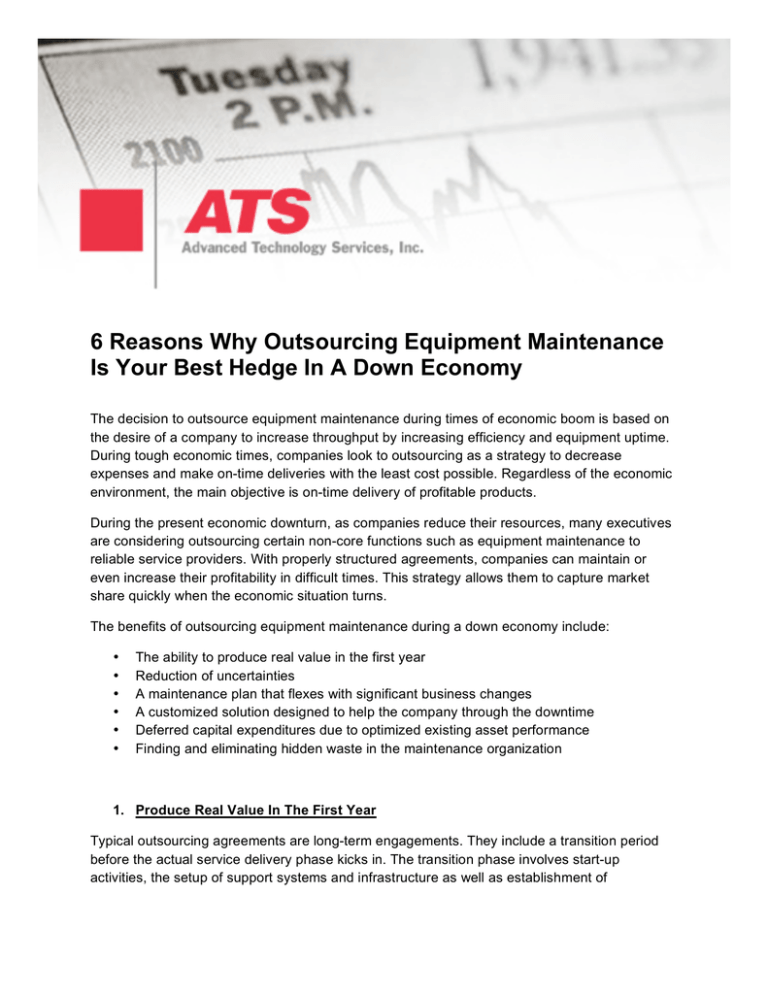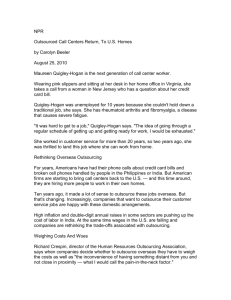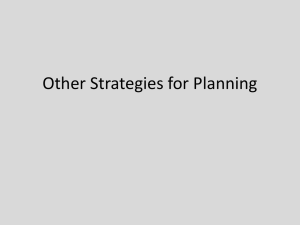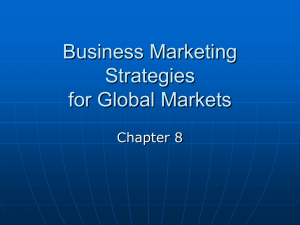6 Reasons Why Outsourcing Equipment Maintenance
advertisement

6 Reasons Why Outsourcing Equipment Maintenance Is Your Best Hedge In A Down Economy The decision to outsource equipment maintenance during times of economic boom is based on the desire of a company to increase throughput by increasing efficiency and equipment uptime. During tough economic times, companies look to outsourcing as a strategy to decrease expenses and make on-time deliveries with the least cost possible. Regardless of the economic environment, the main objective is on-time delivery of profitable products. During the present economic downturn, as companies reduce their resources, many executives are considering outsourcing certain non-core functions such as equipment maintenance to reliable service providers. With properly structured agreements, companies can maintain or even increase their profitability in difficult times. This strategy allows them to capture market share quickly when the economic situation turns. The benefits of outsourcing equipment maintenance during a down economy include: • • • • • • The ability to produce real value in the first year Reduction of uncertainties A maintenance plan that flexes with significant business changes A customized solution designed to help the company through the downtime Deferred capital expenditures due to optimized existing asset performance Finding and eliminating hidden waste in the maintenance organization 1. Produce Real Value In The First Year Typical outsourcing agreements are long-term engagements. They include a transition period before the actual service delivery phase kicks in. The transition phase involves start-up activities, the setup of support systems and infrastructure as well as establishment of management functions and ongoing activities. In a typical outsourcing agreement, the transition phase may last up to 6 months. But while much activity is implemented during this period, the real financial benefits of the outsourcing agreements come later, after the transition period. In the current economic situation, companies do not have the time to wait months to see benefits. Companies are looking for immediate positive results. The outsource provider must align all their activities with the customer’s business needs. It is critical to implement a swift transition plan that addresses key issues, while the support and infrastructure issues are implemented in the background. One tool that is used to assist the strategic alignment between the customer and the outsource provider is the Strategy Map. It indentifies the customer’s objectives and lists the activities and processes that the outsource provider needs to implement in order to support these objectives. The Strategy Map is complemented by the Balanced Score Card – a system that provides metrics to measure success. 2. Help Reduce Uncertainties In a downturn, companies are forced to reduce employees. Internal maintenance groups are reduced, and in some cases, certain capabilities such as predictive maintenance teams are eliminated. As a result, people with specific knowledge of certain tasks are lost. And this comes at a time when those tasks have become more critical in meeting customer expectations. While these corrections are needed to achieve financial goals, they create a high level of uncertainty about the future. Many executives and plant managers face the questions: Will my equipment be ready and reliable to ramp production up when the time comes? How long will it take to regain the skills and knowledge lost? How will this affect the company when the current economic situation changes? A proven outsource organization, specializing in equipment maintenance, can eliminate these uncertainties. That’s because an outsource organization has the technical knowledge and capable technicians to maintain complex, automated equipment. It also has the capabilities to draw additional resources from various locations to complement the on-site team as needed. In addition, an outsource organization will bring systems such as computerized maintenance management software (CMMS) that can tap into equipment history at different locations. This allows the outsource organization to implement the best maintenance practices that have been developed and tested. The process of capturing and sharing technical troubleshooting knowledge in a searchable system linked to the CMMS brings another level of assurance. The result: No key knowledge walks out the door when a maintenance technician leaves. 3. A Maintenance Plan That Flexes With Significant Business Changes There is never a shortage of challenges in manufacturing. When times are good, the challenge is to increase equipment uptime with the least cost possible. In the current economic situation, the challenge is to decrease expenses. Even within an economic slowdown, production demands can change and changes require adjustments to maintenance staffing levels, shift coverage, etc. An outsource organization can provide a solution that accommodates significant changes in the customer’s business, ensuring total alignment for long term support. In many cases, the outsource organization can take on special projects such as equipment moves, relocations, de-commissioning of equipment, projects that, in the past, required bringing in contractors. Combining all these additional activities while working with one outsource partner leads to increased efficiency and cost reduction. 4. Custom Solution For The Downtime Total alignment between the customer’s business needs and the outsource provider’s strategy is key for the success of the relationship. Since the requirements of each customer are unique, the outsource provider needs to develop custom solutions that focus on achieving the customer’s requirements. By introducing tools like Six Sigma and Lean process assessments, the outsource provider can develop solutions to improve the condition of the equipment without increasing the total cost of maintenance. Good maintenance planning and scheduling processes permit accurate forecasting of labor and materials needed. This allows for immediate recognition of labor shortages or excesses and provides factual data needed to evaluate performance or to engage in corrective actions. The outsource provider is further able to perform functions that were previously delivered by outside vendors. On site calibration services and hand tool repair services are just a few examples that will complement the equipment maintenance activities by providing a custom solution focusing on reducing overall cost. 5. Defer Capital Expenditure By Optimizing Existing Asset Performance The outsource provider evaluates the condition of the equipment by analyzing the physical aspects of the asset, maintenance repair and cost data from the CMMS. A plan is then provided to restore the condition of the equipment, which will increase reliability and eliminate the need for spending capital dollars on new equipment. Typically, the equipment restoration plan includes tasks that engage the operator in performing basic care and general condition monitoring. Often, the equipment restoration plan leads into a total productive maintenance (TPM) activity involving production personnel, equipment operators and maintenance. Combining TPM and reliability centered maintenance (RCM) increases team work between the maintenance and production functions. This improves equipment reliability and lowers total operating cost. Applying RCM selectively to fine tune TPM creates optimized maintenance tasks. In general, the definition of RCM is a process used to determine the maintenance requirements of any physical asset in its operating context. This starts with observing the asset as it is being operated in its normal production environment, performing failure mode and effects analysis and developing actions to prevent these failures. The process delivers clear instructions on what is needed to ensure that the equipment continues to operate reliably. 6. Find And Eliminate Hidden Waste The fundamental premise of Lean Principle is the elimination of waste. One of the largest categories of waste in maintenance is the performance of unnecessary maintenance. The maintenance outsource provider addresses this by determining the optimum maintenance interval or frequency and the effect on maintenance cost. These decisions are made based on equipment history, condition, operating environment, usage etc. In addition to optimizing maintenance intervals, there are a number of other considerations in the maintenance optimization process. They include the use of: • • • Predictive maintenance (PdM) technologies to augment the maintenance tasks performed on the equipment. Tools such as thermography cameras, oil analysis, and vibration analyzers provide condition information on components that a visual inspection would not detect. In a well optimized maintenance program these tools are used to eliminate or reduce intrusive maintenance tasks that require disassembly and removal of components for inspection. Detailed equipment analysis based on RCM analysis creates effective and cost efficient maintenance tasks. Root cause analysis (RCA) is used to identify the root cause of problems. RCA is designed to discover not only what or how something happened, but why it happened, and also determines the underlying causes of an event so proper corrective measures can be implemented to prevent any reoccurrences. Maintenance planning and scheduling prioritizes and organizes work so it can be executed in the most efficient manner. It’s getting the right people in the right place with the necessary tools, parts and information to perform the required task. The benefits of proper planning and scheduling include: • • • Cost savings due to efficient use of maintenance labor hours Increased production yield from faster execution of jobs Reduced injuries and stress from a better work flow The outsource provider relies on multi-skilled technicians. A multi-skilled workforce possesses a range of skills that allow them to participate in more than one work process. In practice, these maintenance technicians work across craft boundaries. Over the past 20 years, maintenance has changed, perhaps more so than other disciplines. Complex equipment, new maintenance techniques, automation and increase in the number and variety of assets are just a few examples that drove these changes. Maintenance technicians have to learn new skills to be ready to effectively address equipment problems. Everyone in manufacturing knows that training is important, but in difficult times, training budgets are among the first ones to be reduced and maintenance training budgets are most likely cut or frozen. The maintenance outsource provider has internal training programs that continuously improve and diversify the skills of the technicians. The training is not limited to technical training only, as it also covers matters like the business imperatives specific to the organization. This may include problem solving techniques, team building and facilitation skills. Additionally, training for managers and supervisors focuses on their leadership role, communication, coaching and behavior that will aligns maintenance efforts with the goals of the organization. Another important process focusing on the elimination of waste is Six Sigma. Using the Six Sigma system improves maintenance processes, efficiency, services and customer experience. This process creates the culture of continuous improvement. In conclusion The outsource provider will help companies achieve their strategic goals allowing them to focus primarily on their customers. Companies that make the decision to outsource equipment maintenance will have access to world class maintenance services and will be ready when the economy turns around.





